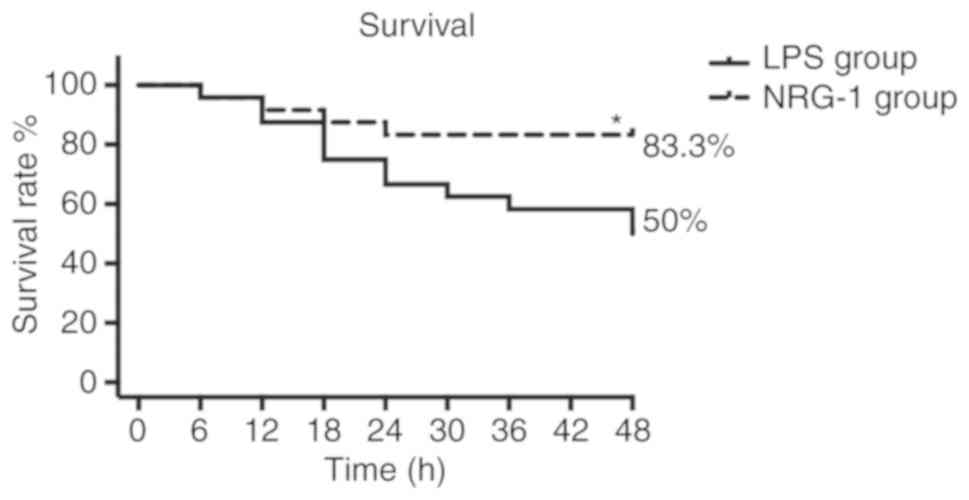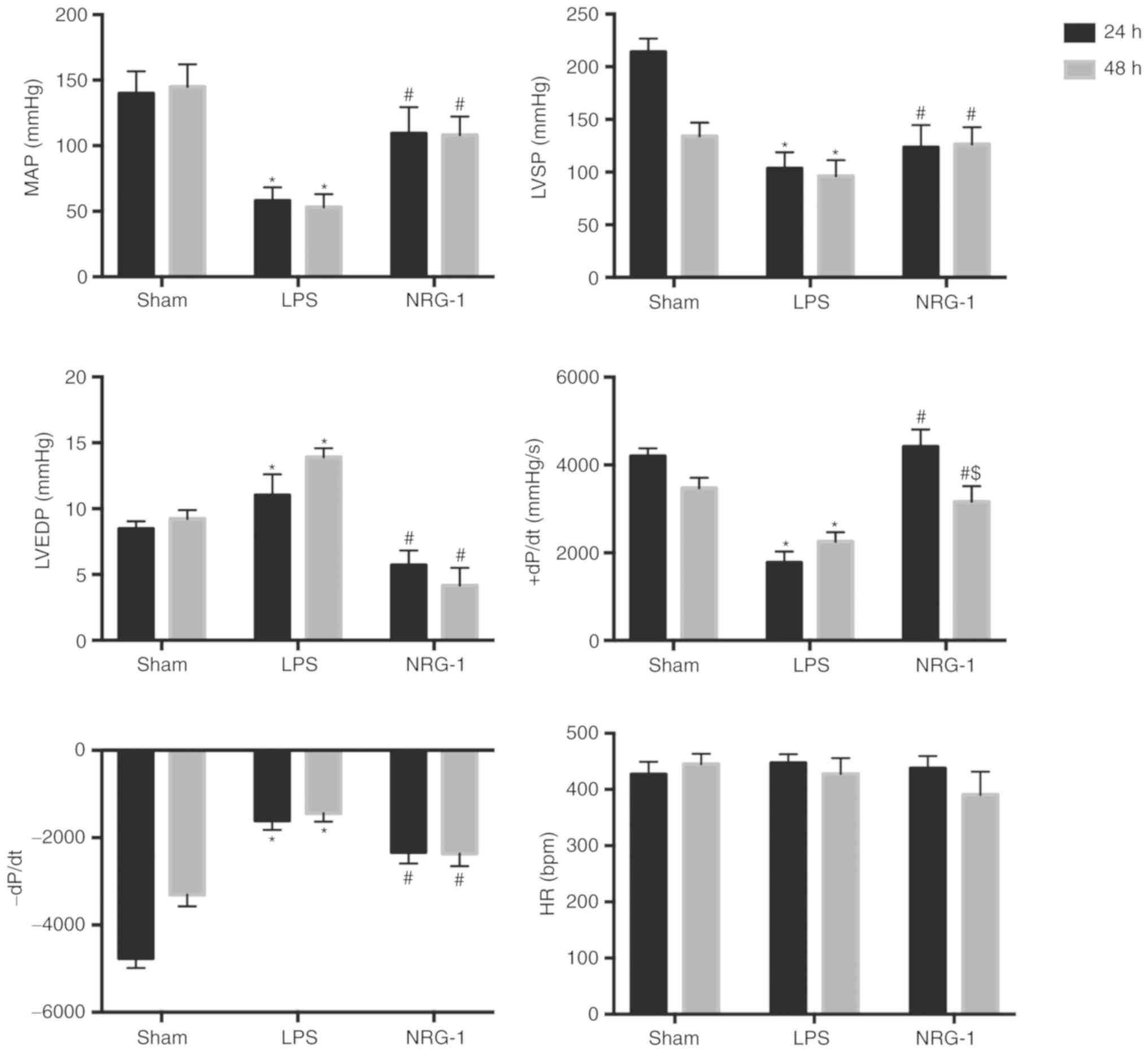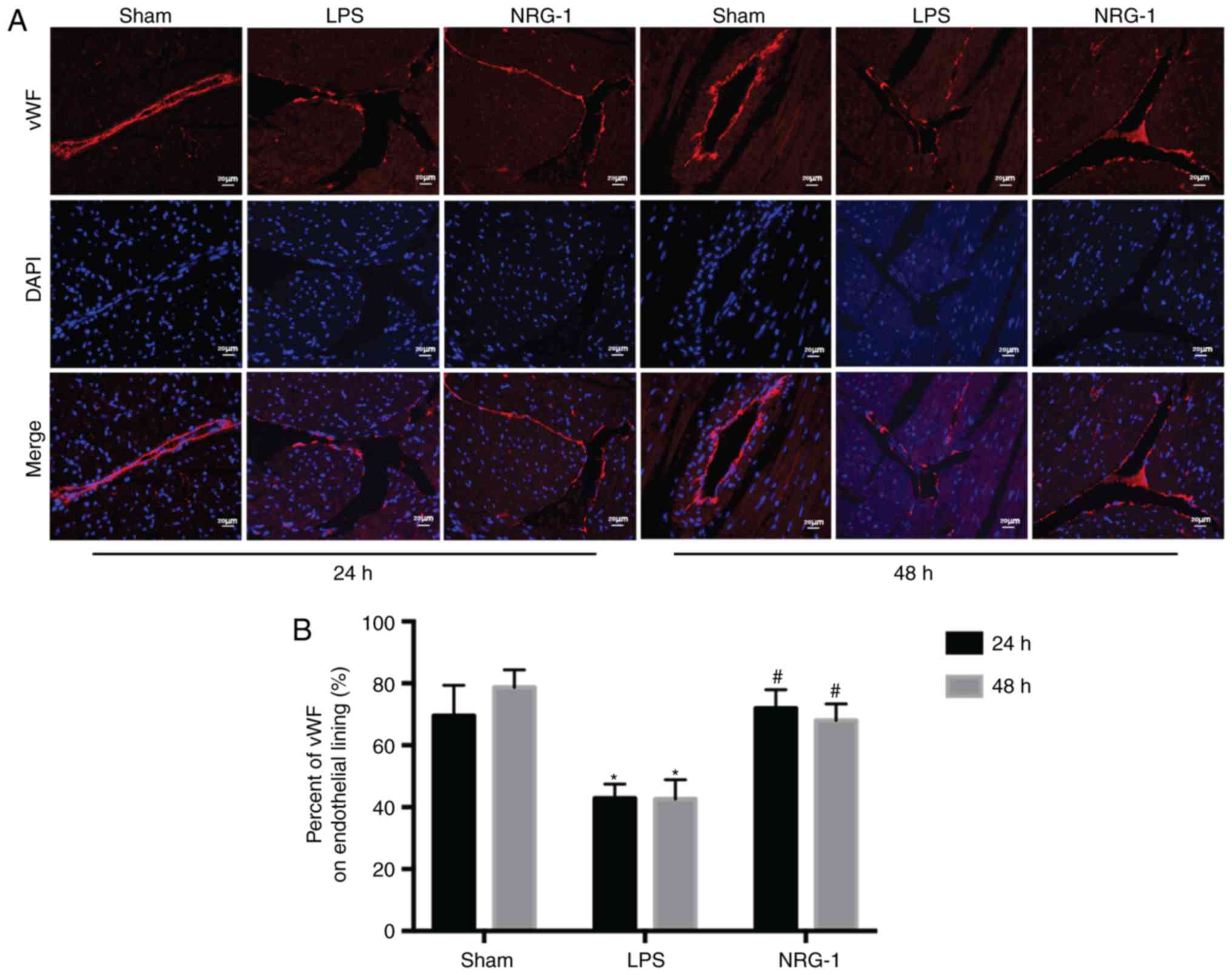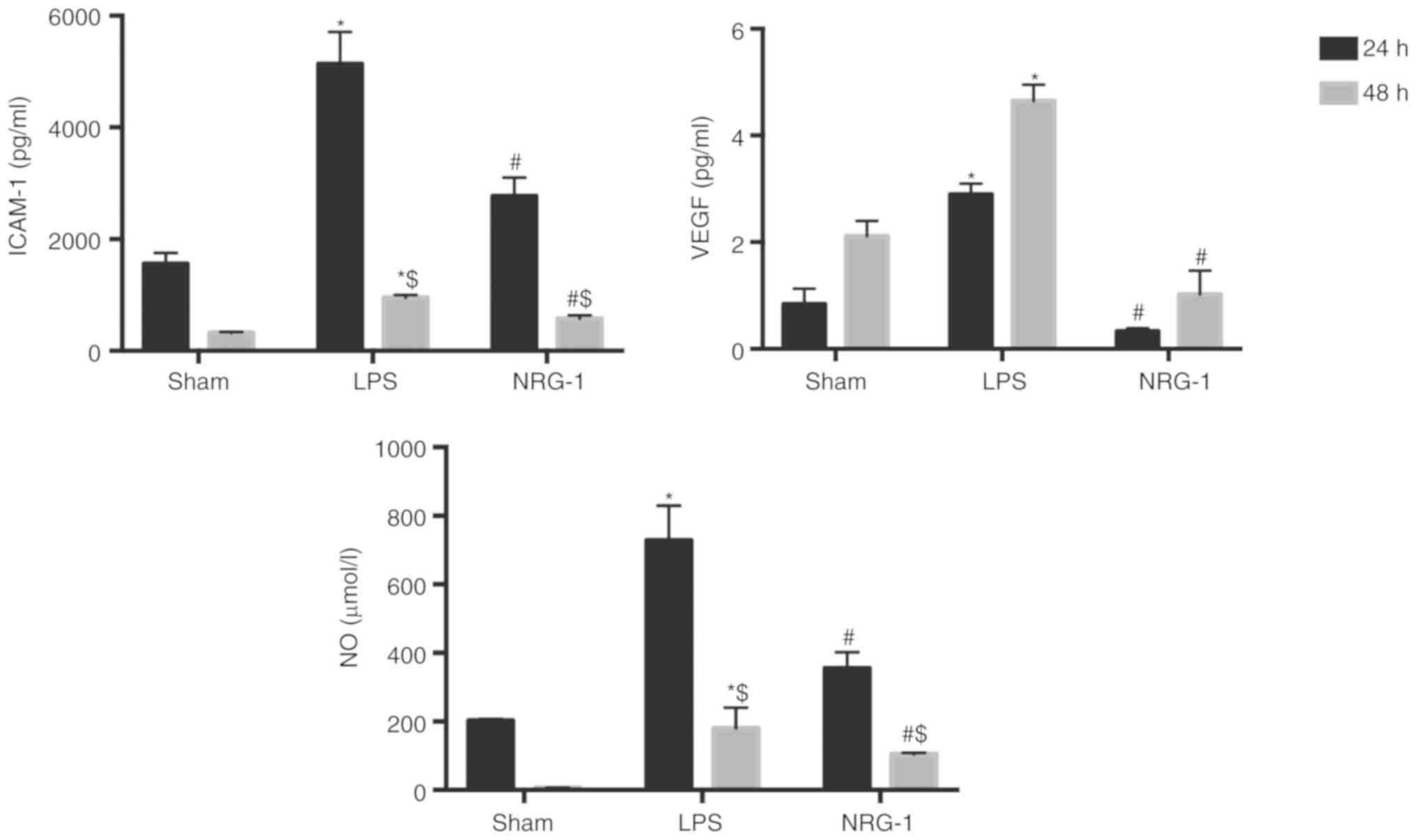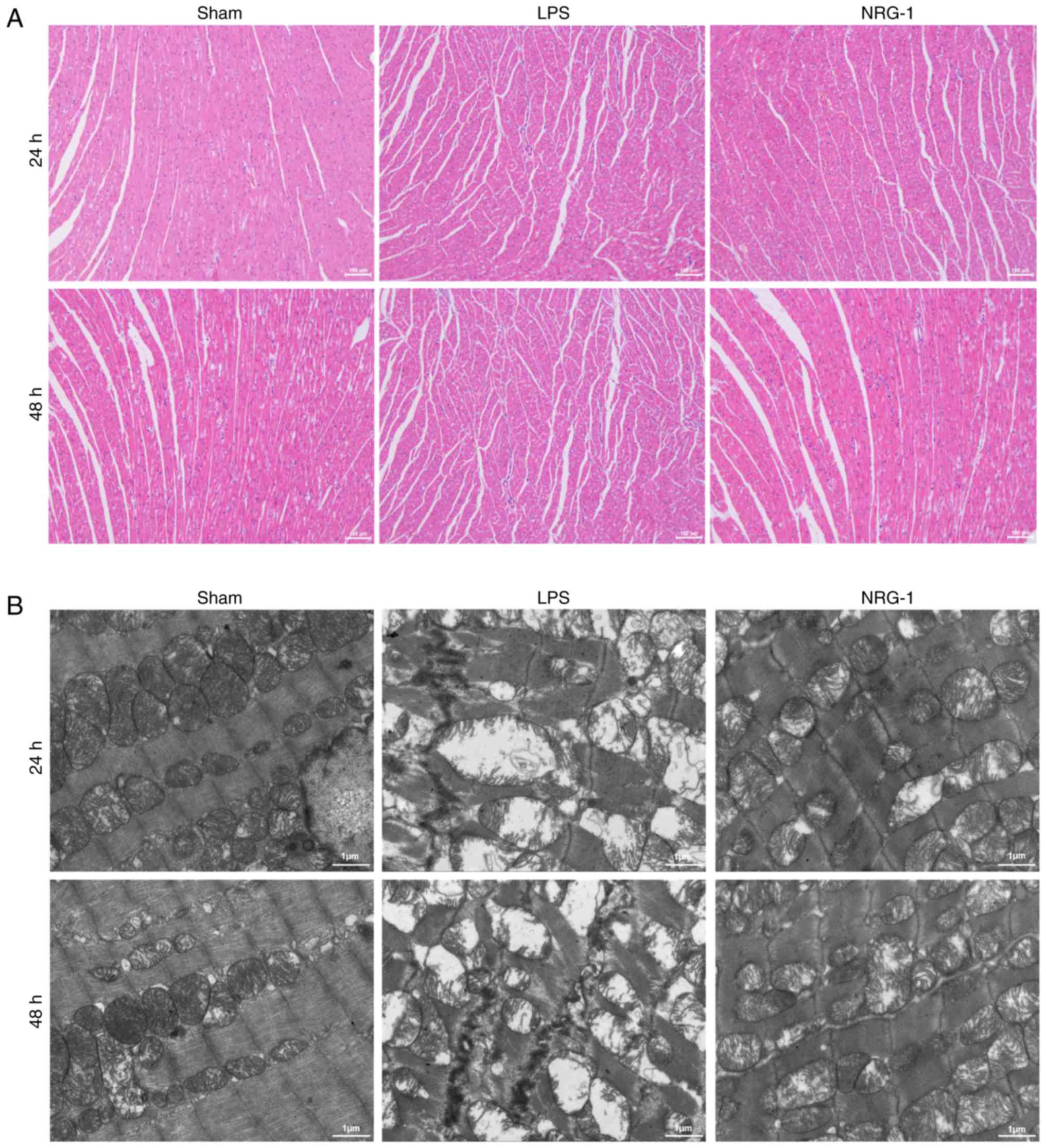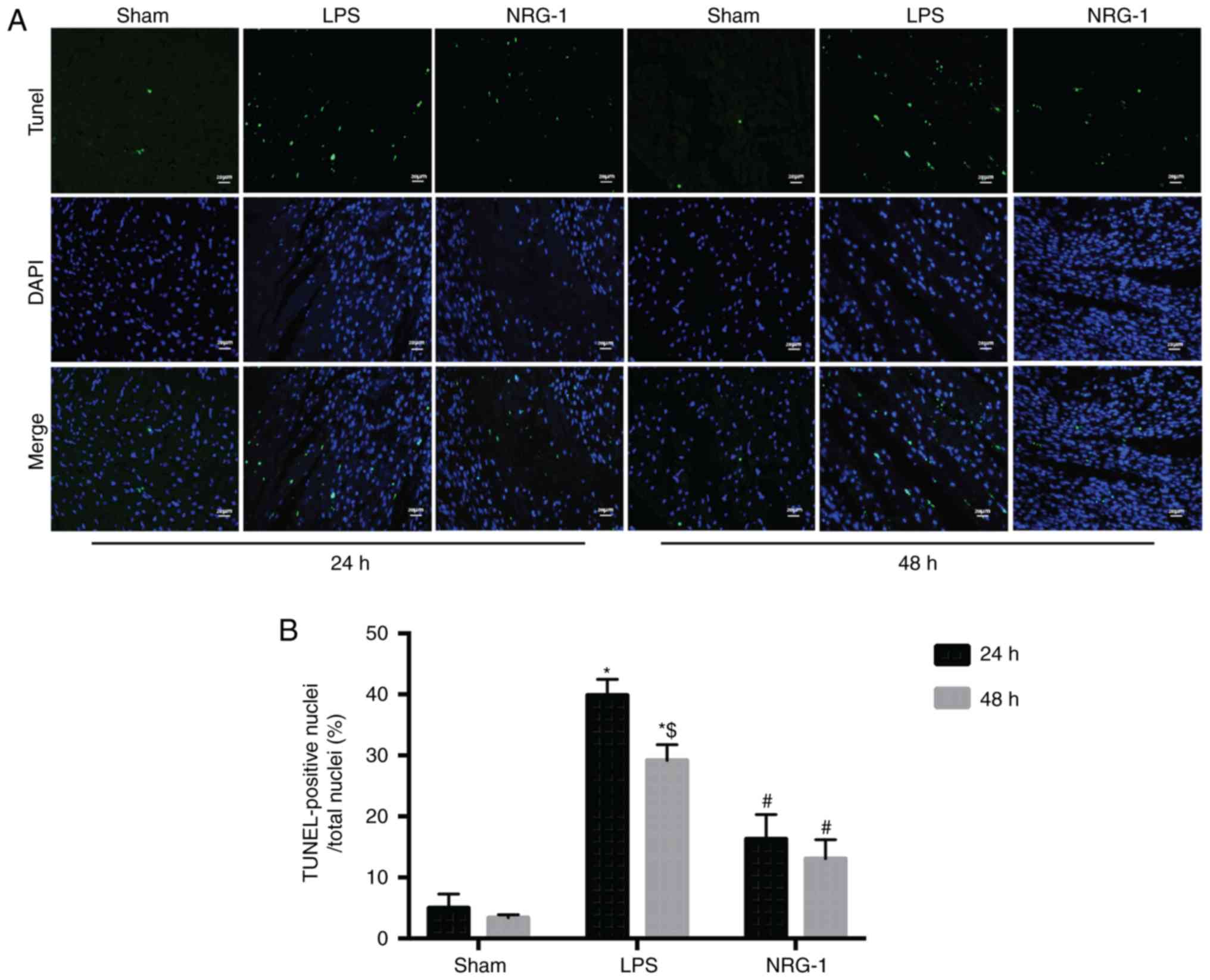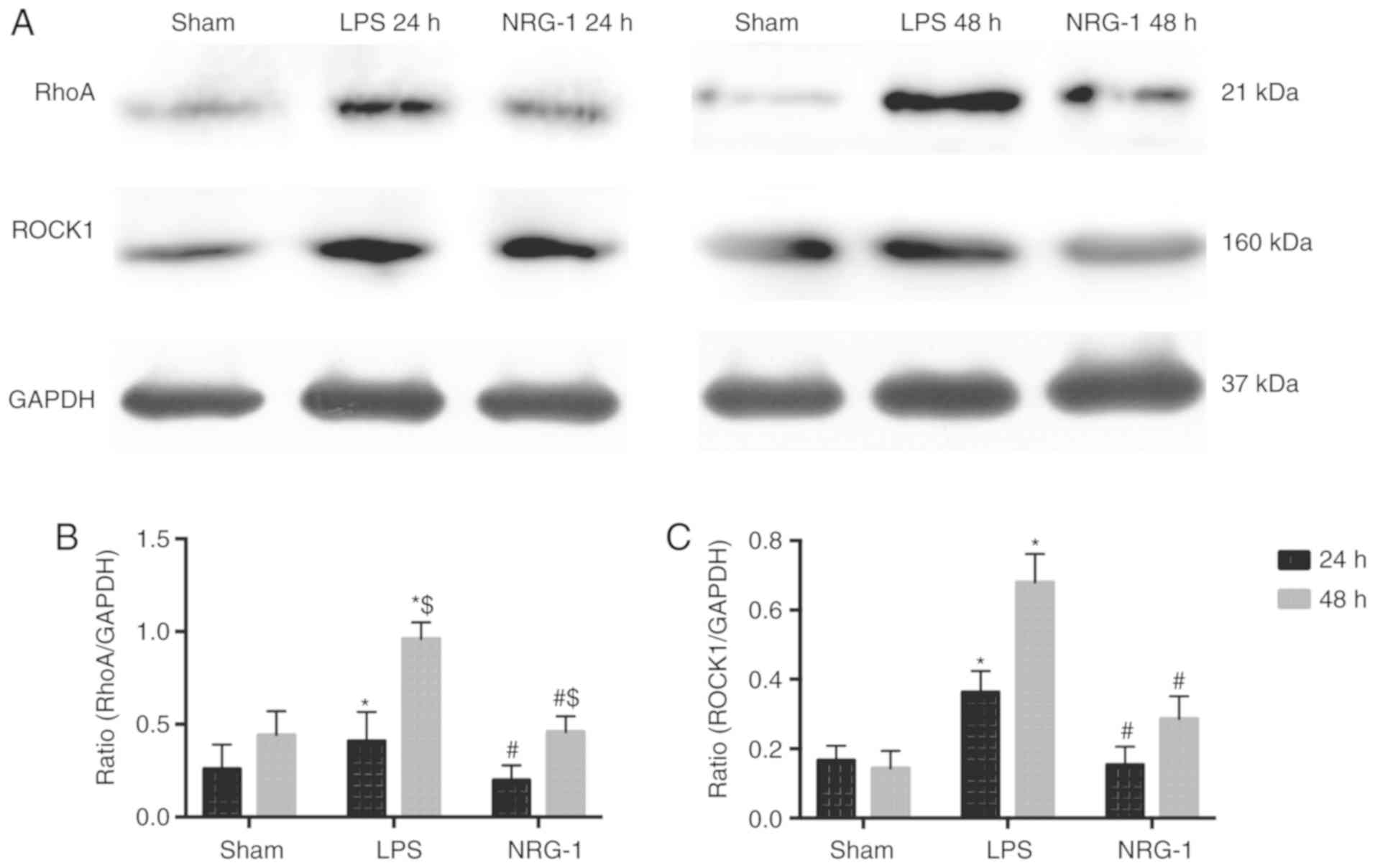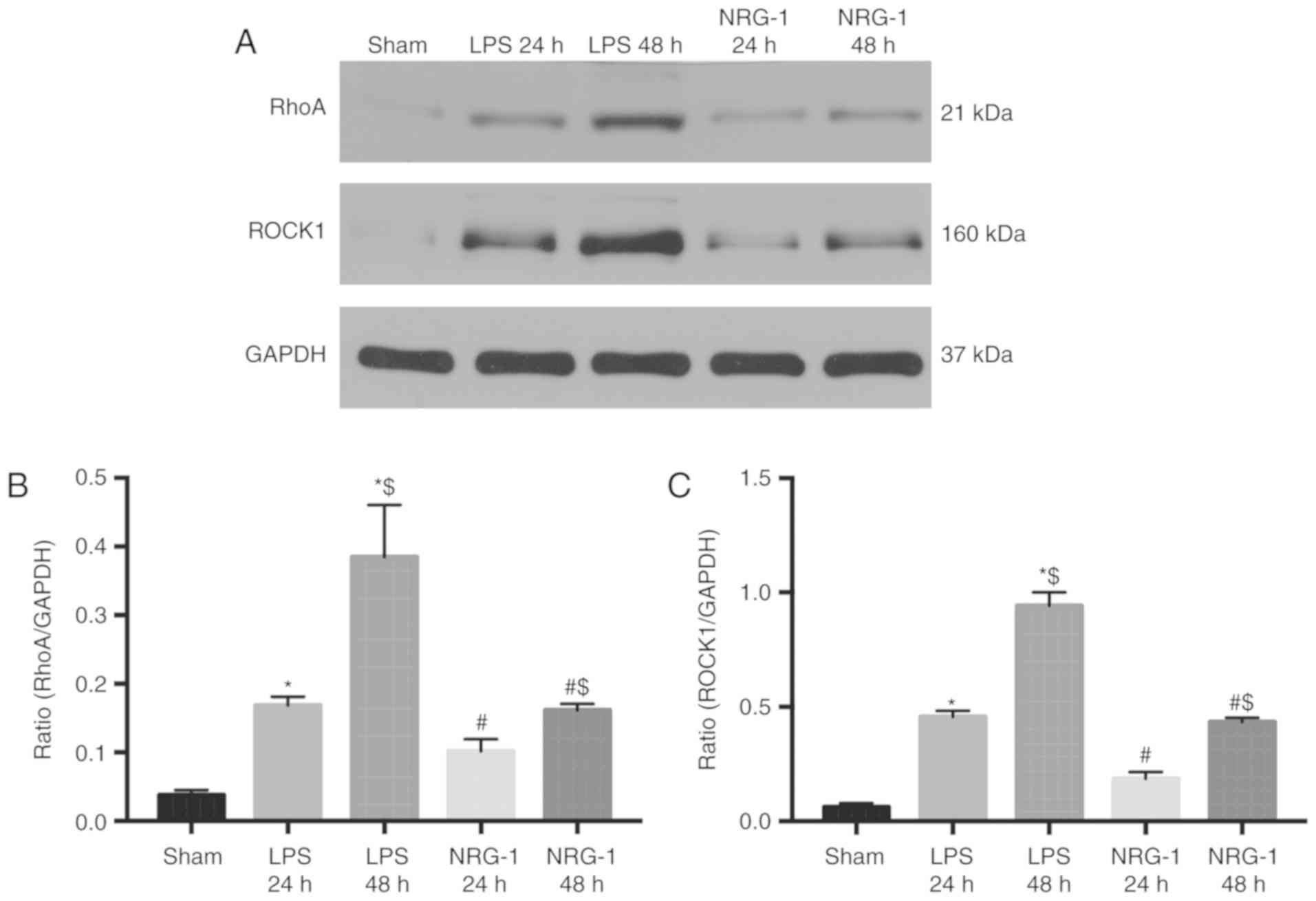|
1
|
Seymour CW, Liu VX, Iwashyna TJ,
Brunkhorst FM, Rea TD, Scherag A, Rubenfeld G, Kahn JM,
Shankar-Hari M, Singer M, et al: Assessment of clinical criteria
for sepsis. For the third international consensus definitions for
sepsis and septic shock (Sepsis-3). JAMA. 315:762–774. 2016.
View Article : Google Scholar : PubMed/NCBI
|
|
2
|
Opal SM and van der Poll T: Endothelial
barrier dysfunction in septic shock. J Internal Med. 277:277–293.
2015. View Article : Google Scholar
|
|
3
|
Boonla O, Kukongviriyapan U, Pakdeechote
P, Kukongviriyapan V, Pannangpetch P, Prachaney P and Greenwald SE:
Curcumin improves endothelial dysfunction and vascular remodeling
in 2K-1C hypertensive rats by raising nitric oxide availability and
reducing oxidative stress. Nitric Oxide. 42:44–53. 2014. View Article : Google Scholar : PubMed/NCBI
|
|
4
|
Park MH, Heo SJ, Park PJ, Moon SH, Sung
SH, Jeon BT and Lee SH: 6,6′-Bieckol isolated from ecklonia cava
protects oxidative stress through inhibiting expression of ROS and
proinflammatory enzymes in high-glucose-induced human umbilical
vein endothelial cells. Appl Biochem Biotechnol. 174:632–643. 2014.
View Article : Google Scholar : PubMed/NCBI
|
|
5
|
Reverri EJ, Morrissey BM, Cross CE and
Steinberg FM: Inflammation, oxidative stress, and cardiovascular
disease risk factors in adults with cystic fibrosis. Free Radic
Biol Med. 76:261–277. 2014. View Article : Google Scholar : PubMed/NCBI
|
|
6
|
Leligdowicz A, Richard-Greenblatt M,
Wright J, Crowley VM and Kain KC: Endothelial activation: The
Ang/Tie axis in sepsis. Front Immunol. 9:8382018. View Article : Google Scholar : PubMed/NCBI
|
|
7
|
Liu M, Solomon W, Cespedes JC, Wilson NO,
Ford B and Stiles JK: Neuregulin-1 attenuates experimental cerebral
malaria (ECM) pathogenesis by regulating ErbB4/AKT/STAT3 signaling.
J Neuroinflamm. 15:1042018. View Article : Google Scholar
|
|
8
|
Howell MD and Davis AM: Management of
sepsis and septic shock. JAMA. 317:847–848. 2017. View Article : Google Scholar : PubMed/NCBI
|
|
9
|
Xiao J, Li B, Zheng Z, Wang M, Peng J, Li
Y and Li Z: Therapeutic effects of neuregulin-1 gene transduction
in rats with myocardial infarction. Coron Artery Dis. 23:460–468.
2012. View Article : Google Scholar : PubMed/NCBI
|
|
10
|
Parodi EM and Kuhn B: Signaling between
microvascular endothelium and cardiomyocytes through neuregulin.
Cardiovasc Res. 102:194–204. 2014. View Article : Google Scholar : PubMed/NCBI
|
|
11
|
Orlandi A and Bennett M: Progenitor
cell-derived smooth muscle cells in vascular disease. Biochem
pharmacol. 79:1706–1713. 2010. View Article : Google Scholar : PubMed/NCBI
|
|
12
|
Zhou Q, Pan X, Wang L, Wang X and Xiong D:
The protective role of neuregulin-1: A potential therapy for
sepsis-induced cardiomyopathy. Eur J Pharmacol. 788:234–240. 2016.
View Article : Google Scholar : PubMed/NCBI
|
|
13
|
Lenihan DJ, Anderson SA, Lenneman CG,
Brittain E, Muldowney JAS III, Mendes L, Zhao PZ, Iaci J, Frohwein
S, Zolty R, et al: A phase I, single ascending dose study of
cimaglermin alfa (neuregulin 1β3) in patients with systolic
dysfunction and heart failure. JACC Basic Transl Sci. 1:576–586.
2016. View Article : Google Scholar : PubMed/NCBI
|
|
14
|
National Research Council (US) Committee
for the Update of the Guide for the Care and Use of Laboratory
Animals: Guide for the Care and Use of Laboratory Animals. 8th ed.
National Academies Press (US); Washington, DC: 2011
|
|
15
|
Liao MH, Shih CC, Tsao CM, Chen SJ and Wu
CC: RhoA/Rho-kinase and nitric oxide in vascular reactivity in rats
with endotoxaemia. PLoS One. 8:e563312013. View Article : Google Scholar : PubMed/NCBI
|
|
16
|
Hotchkiss RS and Karl IE: The
pathophysiology and treatment of sepsis. N Engl J Med. 348:138–150.
2003. View Article : Google Scholar : PubMed/NCBI
|
|
17
|
Candel FJ, Borges Sá M, Belda S, Bou G,
Del Pozo JL, Estrada O, Ferrer R, González Del Castillo J,
Julián-Jiménez A, Martín-Loeches I, et al: Current aspects in
sepsis approach. Turning things around. Rev Esp Quimioter.
31:298–315. 2018.PubMed/NCBI
|
|
18
|
Lee J, Lee S, Zhang H, Hill MA, Zhang C
and Park Y: Interaction of IL-6 and TNF-α contributes to
endothelial dysfunction in type 2 diabetic mouse hearts. PLoS One.
12:e01871892017. View Article : Google Scholar
|
|
19
|
Qi D, Wang D, Zhang C, Tang X, He J, Zhao
Y, Deng W and Deng X: Vaspin protects against LPS-induced ARDS by
inhibiting inflammation, apoptosisand reactive oxygen species
generation in pulmonary endothelial cells via the Akt/GSK-3β
pathway. Int J Mol Med. 40:1803–1817. 2017.PubMed/NCBI
|
|
20
|
Stefanec T: Endothelial apoptosis: Could
it have a role in the pathogenesis and treatment of disease. Chest.
117:841–854. 2000. View Article : Google Scholar : PubMed/NCBI
|
|
21
|
Ma MM, Li Y, Liu XY, Zhu WW, Ren X, Kong
GQ, Huang X, Wang LP, Luo LQ and Wang XZ: Cyanidin-3-O-Glucoside
ameliorates lipopolysaccharide-induced injury both in vivo and in
vitro suppression of NF-kB and MAPK pathways. Inflammation.
38:1669–1682. 2015. View Article : Google Scholar : PubMed/NCBI
|
|
22
|
Sakuragi T, Lin X, Metz CN, Ojamaa K, Kohn
N, Al-Abed Y and Miller EJ: Lung-derived macrophage migration
inhibitory factor in sepsis induces cardio-circulatory depression.
Surg Infect (Larchmt). 8:29–40. 2007. View Article : Google Scholar
|
|
23
|
Jiang S, Li S, Hu J, Xu X, Wang X, Kang X,
Qi J, Lu X, Wu J, Du Y and Xiao Y: Combined delivery of
angiopoietin-1 gene and simvastatin mediated by anti-intercellular
adhesion molecule-1 antibody-conjugated ternary nanoparticles for
acute lung injury therapy. Nanomedicine. 15:25–36. 2019. View Article : Google Scholar
|
|
24
|
Yano K, Liaw PC, Millington JM, Shih SC,
Okada H, Bodyak N, Kang PM, Toltl L, Belikoff B, Buras J, et al:
Vascular endothelial growth factor is an important determinant of
sepsis morbidity and mortality. J Exp Med. 203:1447–1458. 2006.
View Article : Google Scholar : PubMed/NCBI
|
|
25
|
Jacobson SH, Egberg N, Hylander B and
Lundahl J: Correlation between soluble markers of endothelial
dysfunction in patients with renal failure. Am J Nephrol. 22:42–47.
2002. View Article : Google Scholar : PubMed/NCBI
|
|
26
|
Kwon O, Hong SM, Sutton TA and Temm CJ:
Preservation of peritubular capillary endothelial integrity and
increasing pericytes may be critical to recovery from postischemic
acute kidney injury. Am J Physiol Renal Physiol. 295:F351–F359.
2008. View Article : Google Scholar : PubMed/NCBI
|
|
27
|
Barth E, Radermacher P, Thiemermann C,
Weber S, Georgieff M and Albuszies G: Role of inducible nitric
oxide synthase in the reduced responsiveness of the myocardium to
catecholamines in a hyper dynamic, murine model of septic shock.
Crit Care Med. 34:307–313. 2006. View Article : Google Scholar : PubMed/NCBI
|
|
28
|
Hervent AS, Vandekerckhove L and Keulenaer
GWD: Neuregulin-1 antagonizes myocardial fibrosis and diastolic
dysfunction in angiotensin-II treated mice. Eur Heart J. 34:24–34.
2013. View Article : Google Scholar
|
|
29
|
Turner A, Tsamitros M and Bellomo R:
Myocardial cell injury in septic shock. Crit Care Med.
27:1775–1780. 1999. View Article : Google Scholar : PubMed/NCBI
|
|
30
|
Guo LW, Gao L, Rothschild J, Su B and
Gelman IH: Control of protein kinase C activity, phorbol
ester-induced cytoskeletal remodeling, and cell survival signals by
the scaffolding protein SSeCKS/GRAVIN/AKAP12. J Biol Chem.
286:38356–38366. 2011. View Article : Google Scholar : PubMed/NCBI
|
|
31
|
Galindo CL, Ryzhov S and Sawyer DB:
Neuregulin as a heart failure therapy and mediator of reverse
remodeling. Curr Heart Fail Rep. 11:40–49. 2015. View Article : Google Scholar
|
|
32
|
Siafakas NM, Antoniou KM and Tzortzaki EG:
Role of angiogenesis and vascular remodeling in chronic obstructive
pulmonary disease. Int J Chron Obstruct Pulmon Dis. 2:453–462.
2007.
|
|
33
|
Mount PF, Kemp BE and Power DA: Regulation
of endothelial and myocardial NO synthesis by multi-site eNOS
phosphorylation. J Mol Cell Cardiol. 42:271–279. 2007. View Article : Google Scholar
|
|
34
|
Sawada N and Liao JK: Targeting eNOS and
beyond: Emerging heterogeneity of the role of endothelial Rho
proteins in stroke protection. Expert Rev Neurother. 9:1171–1186.
2009. View Article : Google Scholar : PubMed/NCBI
|
|
35
|
Li D, Cheng P, Jiang H, Cao T, Wang J, Gao
Y, Lin Y, Wang C, Zhang S, Li J, et al: Vascularization converts
the lineage fate of bone mesenchymal stem cells to endothelial
cells in tissue-engineered bone grafts by modulating FGF2-RhoA/ROCK
signaling. Cell Death Dis. 9:9592018. View Article : Google Scholar : PubMed/NCBI
|
|
36
|
Rana MK and Worthylake RA: Novel mechanism
for negatively regulating Rho-kinase (ROCK) signaling through
Coronin1b protein in neuregulin 1 (NRG-1)-induced tumor cell
motility. J Biol Chem. 287:21836–21845. 2012. View Article : Google Scholar : PubMed/NCBI
|
|
37
|
van Nieuw Amerongen GP, Koolwijk P,
Versteilen A and van Hinsbergh VW: Involvement of RhoA/Rho kinase
signaling in VEGF-induced endothelial cell migration and
angiogenesis in vitro. Arterioscler Thromb Vasc Biol. 23:211–217.
2003. View Article : Google Scholar : PubMed/NCBI
|
|
38
|
Anwar KN, Fazal F, Malik AB and Rahman A:
RhoA/Rho- associated kinase pathway selectively regulates
thrombin-induced intercellular adhesion molecule-1 expression in
endothelial cells via activation of I kappa B kinase beta and
phosphorylation of RelA/p65. J Immunol. 173:6965–6972. 2004.
View Article : Google Scholar : PubMed/NCBI
|
|
39
|
Zhou Z, Guo F, Dou Y, Tang J and Huan J:
Guanine nucleotide exchange factor-H1 signaling is involved in
lipopolysaccharide- induced endothelial barrier dysfunction.
Surgery. 154:621–631. 2013. View Article : Google Scholar : PubMed/NCBI
|
|
40
|
Chen J, Lai J, Yang L, Ruan G, Chaugai S,
Ning Q, Chen C and Wang DW: Trimetazidine prevents
macrophage-mediated septic myocardial dysfunction via activation of
the histone deacetylase sirtuin 1. Br J Pharmacol. 173:545–561.
2016. View Article : Google Scholar
|















